Master Your Meat Grinder Attachment: A Comprehensive Guide
For many home cooks and food enthusiasts, a meat grinder attachment offers incredible versatility in the kitchen. From whipping up savory homemade sausages to crafting the perfect burger patties, having a reliable and user-friendly meat grinder can make all the difference. In this comprehensive guide, we delve into the world of meat grinder attachments, discussing their types, how to assemble and maintain them, tips for proper use, safety precautions, and even delicious recipes to help maximize your culinary potential.
Types of Meat Grinder Attachments
Meat grinder attachments come in various types depending on their purpose and the kind of kitchen appliance they are designed to connect with. Some of the primary styles include standalone electric grinders, manual grinders, and mixer attachments.Standalone electric grinders are powerful and efficient, making them suitable for grinding large quantities of meat. Manual grinders, on the other hand, are hand-powered and ideal for smaller-scale home use. Mixer attachments are designed specifically to connect with specific mixer models, such as those produced by KitchenAid, transforming the mixer into a multi-functional appliance.Materials used in meat grinder attachments also vary depending on the type. Most commonly, grinders are constructed from stainless steel, aluminum, or cast iron. Stainless steel is the most popular choice, as it is resistant to rust and corrosion, making it highly durable and long-lasting. Aluminum is more affordable and lighter in weight but may be less durable over time. Cast iron is heavy-duty and long-lasting but requires regular seasoning and maintenance to prevent rusting and ensure smooth functioning.Size is another significant factor when choosing a meat grinder attachment. Grinder sizes are usually based on the diameter of their output plate, which determines the size of the ground meat pieces. Common sizes range from #5, #8, #12, #22, to #32, with the size increasing as the number increases. Smaller sizes, such as #5 and #8, tend to work best in a home kitchen, while larger sizes, such as #22 and #32, are more suited to commercial settings or those needing to process large quantities of meat.Additionally, meat grinder attachments often come with a variety of accessories for added functionality. These accessories can include grinding plates with different hole sizes for varied coarseness, sausage stuffing tubes for making homemade sausages, and kubbe attachments for making Middle Eastern dishes like kibbeh. It is important to ensure that the accessories available for a particular grinder attachment are compatible with the appliance with which it will be used, as there may be variations in the accessory compatibility between brands and models.
When looking to purchase a meat grinder attachment, it’s vital to consider its compatibility with various kitchen appliances. Some attachments are designed exclusively for specific models or brands, such as KitchenAid mixer attachments, which only work with KitchenAid mixers. On the other hand, universal grinder attachments can fit a wider array of appliance models. Understanding the compatibility requirements will ensure that the chosen grinder attachment functions seamlessly with your existing kitchen equipment and provides a smooth grinding experience.
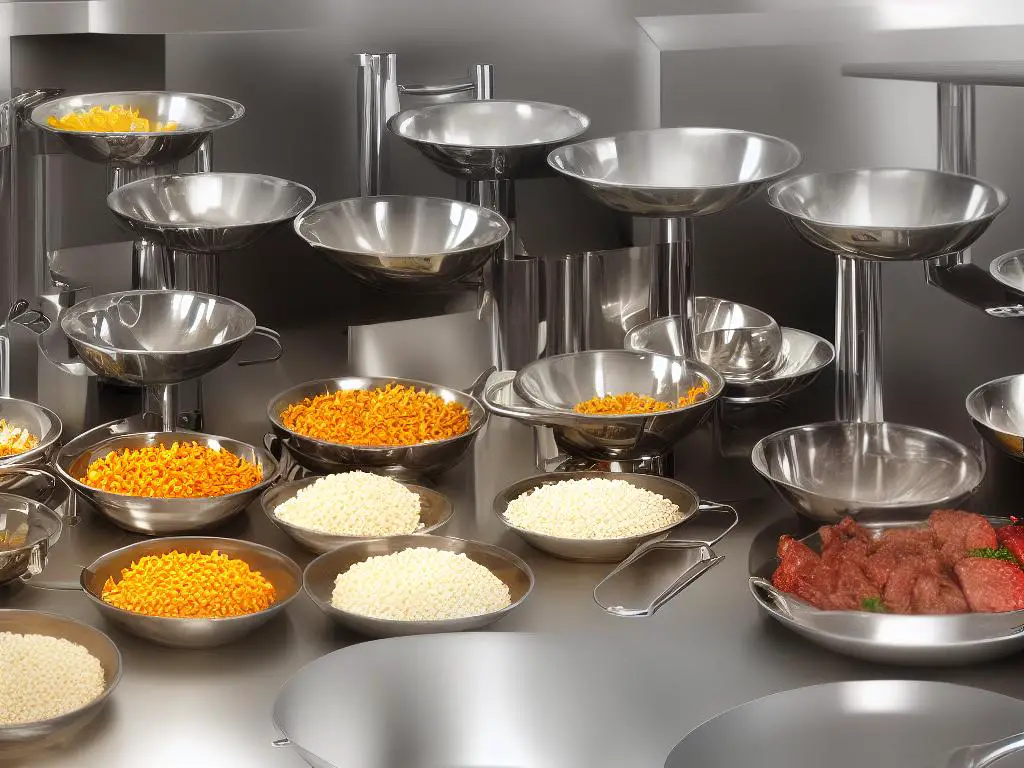
Assembly and Maintenance
Meat grinder attachments, such as the one discussed in the previous paragraph, make it easy for you to grind your own meat, allowing full control over the texture and quality. These attachments are simple to assemble and disassemble, and no specialized equipment is needed for the process.
For assembly, connect the grinder body to your stand mixer, secure the feed screw within the grinder, and attach the grinding plate, knife, and ring. Ensure the notches on the grinding plate and knife are properly aligned, as this will lock them together and guarantee an even grind for your meat.
Disassembling the meat grinder attachment after use is equally important, as this allows for efficient and thorough cleaning. To disassemble your meat grinder, first disconnect it from your stand mixer. Then, remove the ring, grinding plate, and knife in the reverse order of assembly. Lastly, unscrew the cap from the end of the grinder, and pull out the feed screw and any remaining parts.
Proper cleaning of your meat grinder attachment is vital to ensure both its hygiene and longevity. After disassembling the grinder, wash each part in warm, soapy water, using a soft brush to scrub away any residual bits of meat. Avoid using abrasive cleaners or steel wool, as these can scratch and damage the grinder’s surfaces. For parts that are dishwasher safe, be sure to follow the manufacturer’s guidelines. Once everything is cleaned and rinsed, allow all parts to air dry completely before reassembling, as dampness can lead to rust and bacterial growth.
Storage of your meat grinder attachment is crucial for maintaining its quality and preventing damage. When storing your grinder, ensure that all parts are completely dry. Keep the attachment in a cool, dry place, away from moisture and extreme temperatures. To prevent the grinder’s cutting edges from dulling, store the grinding plates and knives separately, and avoid stacking them on top of each other. You can also wrap them in a soft cloth or paper towel to keep them protected.
Regular maintenance and understanding of your meat grinder attachment are crucial for its long-lasting performance and optimal results. Be sure to periodically inspect the attachment for any signs of wear or damage, such as cracks, nicks, or dull edges on the grinding plates and knives. Should you notice any issues, replace the affected parts as needed to maintain top performance. Alongside proper cleaning, storage, and inspections, it’s essential to follow the manufacturer’s recommendations when using your meat grinder attachment. This includes adhering to the suggested speed settings and avoiding overloading the grinder with too much meat at once. By following these guidelines, you can expect your meat grinder attachment to remain in great working condition for many years.
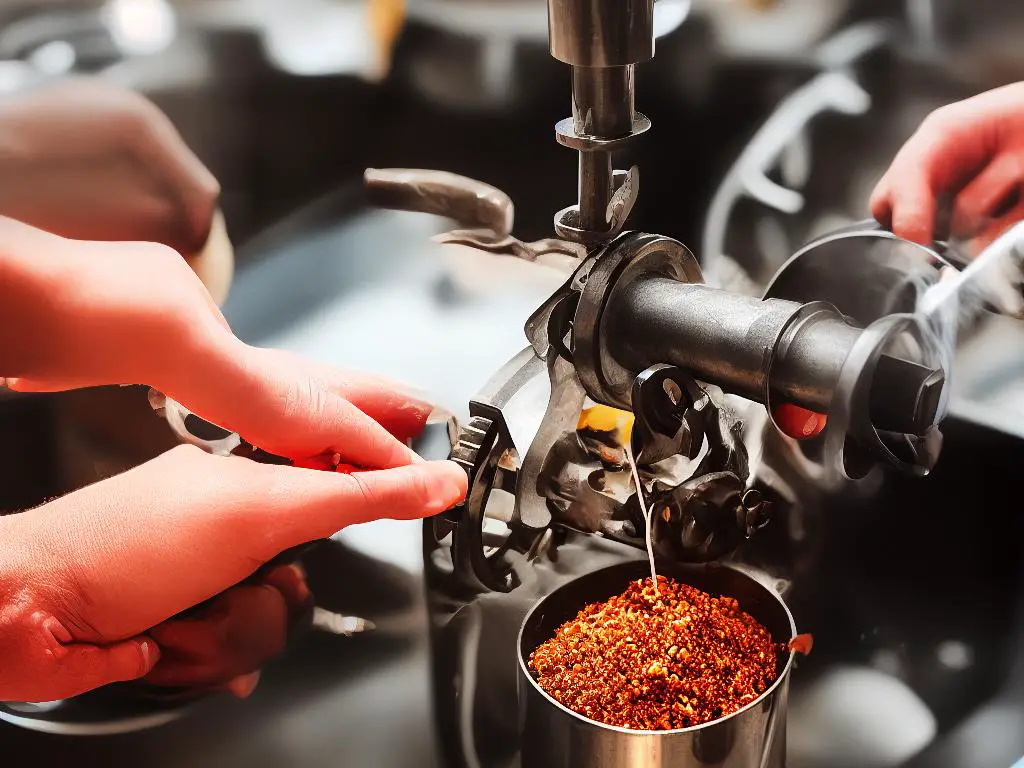
Grinding Techniques and Tips
Grinding your own meat with a meat grinder attachment allows you to have better control over the quality and texture of the meat you consume, and can even save you money compared to buying pre-ground meat. A seamless connection between the two processes can truly enhance your experience.
Proper handling of the meat is essential for successful grinding. Always begin with cold meat, as it holds its shape better during the grinding process and helps prevent clogging or smearing. To ensure an even and consistent grind, it is recommended to partially freeze the meat for about 30 minutes before grinding. By considering these factors, you will be well-equipped to get the most out of your meat grinder attachment, resulting in delicious and cost-effective meals.
Adjusting the grind size is another crucial factor in achieving your desired texture and consistency. Meat grinder attachments typically come with multiple grinding plates with varying hole sizes, giving you the ability to choose between a coarse or fine grind. Depending on the dish you are preparing, a coarse grind may be preferred for recipes like chili, while a fine grind works well for meatballs or sausages. Experiment with different plates for a better understanding of the resulting textures and to identify your personal preference.
To ensure even grinding, it is important to maintain a steady pace while feeding the meat into the grinder. Overloading the grinder can lead to uneven texture and, in some cases, jamming or clogging. The use of a pusher or tamper is recommended, as it helps guide the meat into the feeding tube at a consistent pace without the risk of injury. Additionally, alternating between pieces of meat and fat can contribute to a more uniform mixture, as the numerous layers of fat interspersed throughout the ground meat can greatly enhance the overall flavor and tenderness of the final dish.
Cleaning the grinder attachment as you work can further prevent clogs and other issues. After grinding a batch of meat, push a small piece of bread through the grinder to help remove any meat particles and fat that may be stuck within the mechanism. This will ensure your grinder remains in excellent working order and prevent any unwanted buildup or cross-contamination. Additionally, proper storage of the ground meat is a vital aspect of maintaining freshness and preventing spoilage.
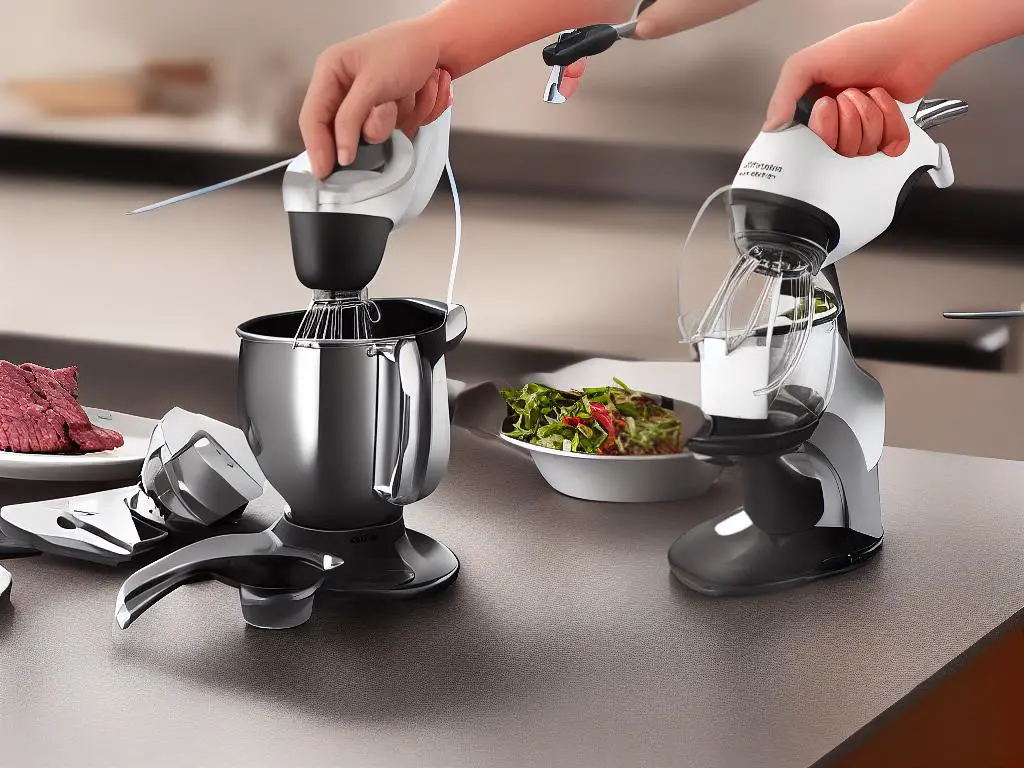
Safety Precautions
Once the meat has been ground, it should be placed in an airtight container and stored in the coldest part of the refrigerator for up to 2 days. It is also important to note that ground meats should be cooked to an internal temperature of at least 160°F to ensure food safety and minimize potential risks associated with bacterial contamination. When using meat grinder attachments, it is crucial to take safety precautions, such as keeping all body parts away from the moving parts during operation. Always ensure that the device is fully assembled and securely fastened before turning it on.
If you need to clear out any clogs or jams, turn off the power source and unplug the machine entirely before attempting to troubleshoot the issue. Using any type of tool, such as a long-handled spatula, to push the meat down and avoid getting your fingers too close to the grinding plates is a key safety measure. By following these grinding techniques and tips, you will be fully equipped to maximize the benefits of using a meat grinder attachment and enjoy delicious, high-quality homemade ground meats.
Proper maintenance and cleaning of your meat grinder attachment are essential for ensuring safety and avoiding cross-contamination. Meat grinders should be thoroughly cleaned after each use to prevent the growth of harmful bacteria. This includes taking apart the attachment, washing all the pieces with hot soapy water, and allowing them to dry completely before reassembling. Always make sure to sharpen or replace dull blades and discard any damaged parts. Frequent and thorough cleanings will help ensure the safety and longevity of your grinder attachment.
It is also important to practice safe food handling procedures when using meat grinder attachments. For instance, make sure that you use gloves to avoid direct contact with raw meat, as it may carry bacteria such as E.coli or salmonella. If you’re grinding multiple types of meat, be sure to clean the attachment in between each batch to prevent cross-contamination between different meats. Additionally, keep the raw meat as cold as possible before it is fed into the grinder by working in small batches and keeping the unprocessed meat in the refrigerator. Chilling the grinder parts before using them can also help maintain the optimal temperature for the meat throughout the process, reducing the risk of bacterial growth.
Some further safety precautions involve creating a clean and organized workspace. This will help prevent accidents and keep your meat processing tasks as efficient as possible. Remove any clutter from your countertop and ensure that all necessary tools and accessories are within arm’s reach before beginning to grind meat. Having a clean and safe workstation will not only make the process more straightforward and less prone to injury but also help to prevent contamination of your ground meat.
A crucial step in becoming informed about meat grinder attachments is to familiarize yourself with the manufacturer’s recommendations and guidelines for the specific model you plan to use. Each attachment may have unique features or precautions that users should be aware of to ensure safe and proper usage. By thoroughly reading the instruction manual and conducting some online research, you can ensure that you are utilizing your meat grinder attachment safely and effectively. Following these precautions and guidelines can help prevent accidents, maintain a hygienic workspace, and produce the best possible results from your meat grinder attachment.
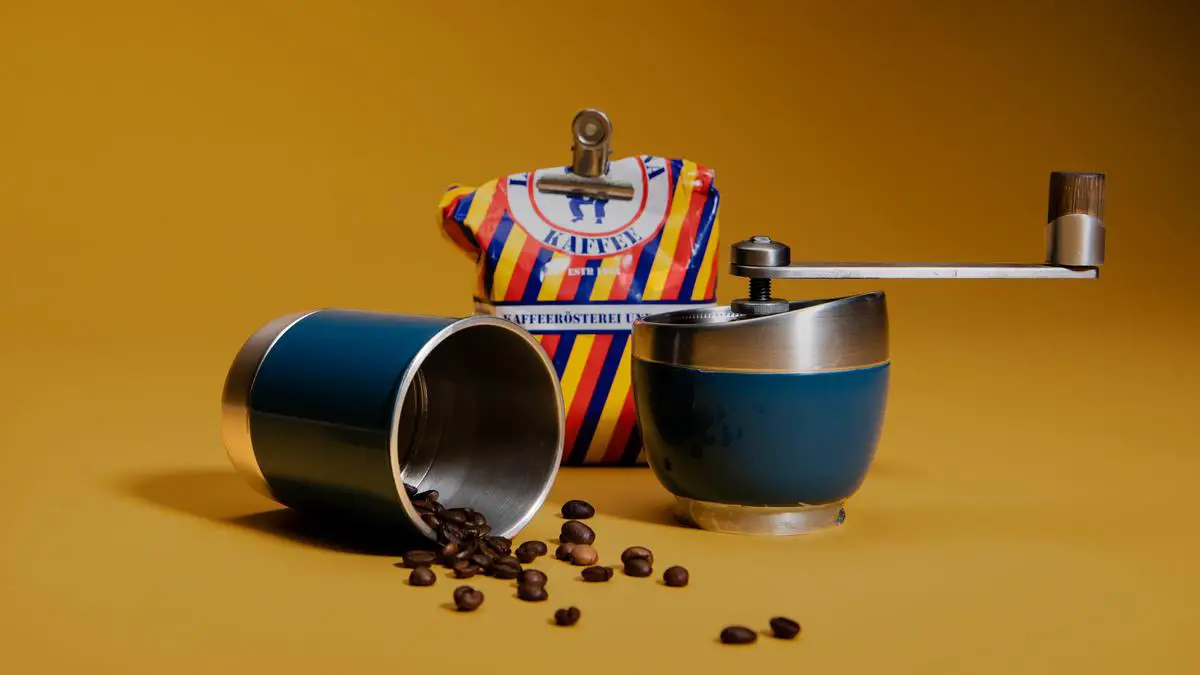
Photo by st_lehner on Unsplash
Recipes and Cooking Ideas
Once you have a solid understanding of how to operate your meat grinder attachment safely, you can begin to explore the variety of culinary opportunities it offers. For example, grinding your blend of meats allows you to experiment with unique homemade sausages, such as chicken and apple, beef and garlic, or spicy lamb sausages. The meat grinder’s versatility enables you to mix in various herbs, spices, and additional flavorings tailored to your taste preferences. You can then serve your cooked sausages alongside fresh vegetables, warm grains, or nestled into a toasted bun, creating the perfect homemade meal using your newfound knowledge of meat grinder attachments.
Not only can a meat grinder attachment help create delicious sausages, but it can also elevate your burger-making game. Grinding your meat at home, whether it’s beef, turkey, or a mix of different protein sources, ensures the quality and freshness of your ingredients while giving you control over the texture and taste. Experiment with seasoning blends, mix in diced onions, garlic, or even jalapeños for some extra kick. Impress guests at your next cookout by serving up homemade burger patties customized to the unique flavor profiles of your friends and family.Another fantastic cooking idea to utilize your meat grinder attachment is meatball creation. Pair ground meats with fresh ingredients like onions, garlic, breadcrumbs, and grated parmesan cheese to create delicious homemade meatballs that can be cooked in a tomato sauce, baked in the oven, or pan-seared for a crisp, flavorful crust. Beyond the traditional Italian-style meatball, try branching out with Asian-inspired flavors, such as ginger chicken or even Swedish-style meatballs, paired with a creamy sauce.Meat grinder attachments are not limited to conventional meats. Seafood lovers can benefit from this fantastic kitchen gadget by making fish cakes or shrimp dumplings. Ground fish mixed with herbs, spices, and a binding agent creates a delicate balance of texture and flavor that works wonderfully in dishes like Thai fish cakes or loaded seafood dip. Fish and seafood served in ground form take on a whole new culinary experience.Using your meat grinder attachment, think outside the box and tackle different types of meat dishes such as stuffed peppers or cabbage rolls. By incorporating ground meats into vegetables or grains, you can craft well-balanced meals with unique textures and flavors. Experiment with different pairings and ingredients, such as Mediterranean-style ground lamb stuffed peppers or Asian-inspired ground pork stuffed cabbage rolls. The possibilities are endless when you dive into the world of recipes and cooking ideas that highlight the capabilities of your meat grinder attachment.
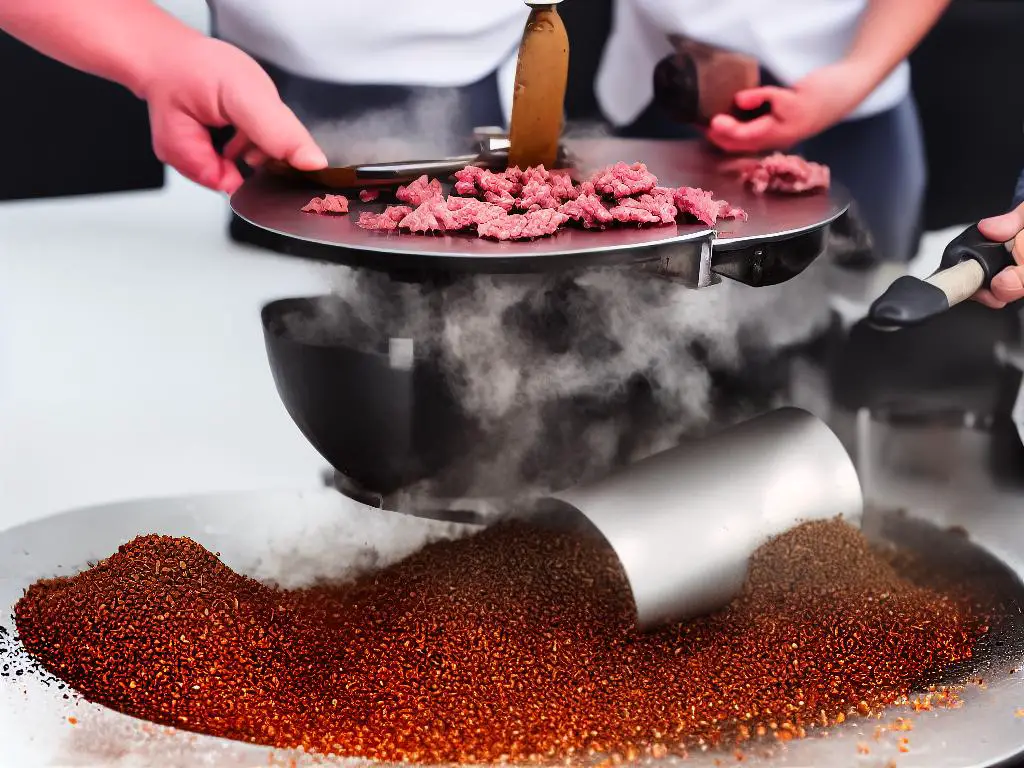
Overall, investing in a quality meat grinder attachment not only elevates your home cooking but also provides a healthier and more sustainable option to store-bought processed meats. By following the guidelines and tips provided in this guide, users can navigate their way through assembling, maintaining, and efficiently using meat grinder attachments, while adhering to proper safety precautions. The ability to create delectable recipes such as sausages, patties, meatballs, and more, right in the comfort of your own kitchen, is truly a testament to the magic and versatility of this handy kitchen gadget.
